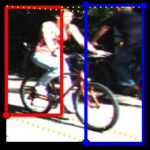 Autonomous vehicles are already pretty good at detecting, and responding accordingly to, other vehicles. Of course, other vehicles are arguably the easiest of the road users autonomous vehicles are likely to share our highways with.
Autonomous vehicles are already pretty good at detecting, and responding accordingly to, other vehicles. Of course, other vehicles are arguably the easiest of the road users autonomous vehicles are likely to share our highways with.
I’ve written a few times about how researchers are working to better enable autonomous cars to safely engage with pedestrians, but cyclists are another matter again.
Autonomously detecting cyclists
That was the subject of a recent study by a team from George Mason University believe they’ve made important progress that will help the vehicles better understand what is a bicycle, and what its intentions are.
The algorithm they’ve developed forms a central part of what they call Deep3DBox, which is able to take a 2D image, identify road users within it, and then create a 3D box that surrounds each of them. It is also capable of determining the direction the vehicle is going in. When the algorithm was tested, it was able to correctly identify 89% of vehicles, but cyclists were another matter, with just 75% of bicycles identified, with much less success determining their direction.
Better scanning equipment and maps will no doubt help improve this statistic, but the inherent unpredictability of cyclists adds an extra layer of difficulty to the task.
“Bicycles are much less predictable than cars,” the authors say, “because it’s easier for them to make sudden turns or jump out of nowhere.”
Surpassing humans
Suffice to say, detecting cyclists is something human drivers are also notoriously bad at, and the authors are confident that technology such as theirs will surpass human abilities. The technology is already being deployed in vehicles to augment the ability of motorists, with manufacturers such as Jaguar and Volvo already deploying bike warning systems.
It remains largely uncertain just how much the arrival of autonomous vehicles will change the makeup of transport in our cities, with researchers already suggesting that vehicles will need to be segmented from pedestrians to avoid gridlock.
Assuming cars and bicycles continue to operate in the same space however, the ability to detect one another will be crucial, so the apparent improvement in this area are very much to be welcomed, both in terms of enabling autonomous technology, but also to augment existing vehicles. As a cyclist myself, this can’t come soon enough.